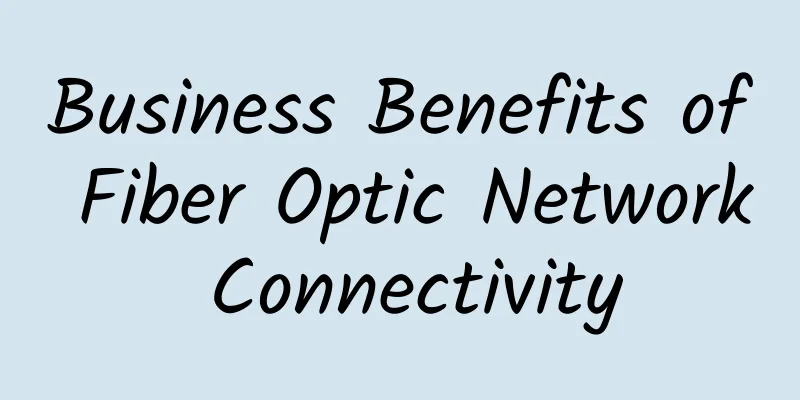Business Benefits of Fiber Optic Network Connectivity

|
As businesses expand globally to gain access to newer and better prospects, resources, and customers, the need to optimally utilize technological advancements has increased tremendously. Networking and telecommunications can play a huge role in this regard. High-speed internet connectivity and seamless communication over long distances are the needs of today’s businesses as they are the driving force for growth and productivity. Most businesses still use copper-grade legacy networks, which are not sufficient for long-distance transmission, sending large files, live video streaming, online conferencing, and more. In addition, they also have issues with signal strength and speed. For example, even if you use Cat6 cables for long-distance transmission, the speed may slow down or the signal may weaken over time. This is where fiber optics are attractive because all these disadvantages can be eliminated. Fiber optics offer high speeds. Long-distance transmission can reach up to 100 kilometers or more without problems such as signal attenuation, electromagnetic interference, and even hacking. This article mainly discusses the contribution of optical fiber in promoting business development through fast data transmission, seamless connectivity, etc. What is fiber optics and why is it so important?In a typical traditional network, data is transmitted in the form of electrical signals through UTP copper cables or Ethernet cables (mainly Cat5e or Cat6) with routers or switches, computers, and other devices on the network (such as phones, cameras, etc.). These signals are converted into analog signals at the receiving end. During the transmission process, the signal may weaken or the data transmission may be delayed due to noise and crosstalk. Moreover, the transmission distance here can only increase by a few meters at most, and there may also be data security issues. Fiber optics, on the other hand, eliminates all these problems. It transmits signals in the form of light pulses, which are converted into analog signals at the receiving end. This eliminates the problems of EMI, crosstalk, etc. Moreover, fiber optics are difficult to hack and are therefore more secure. But the best part is that you can mix fiber optics with the existing traditional network. This helps increase the transmission distance, speed, connectivity, and security of the existing network within a limited budget. The demand for optical fibers in business applications is increasing. They are used in local area network applications as well as remote applications such as video conferencing. Want to know how to enhance your video conferencing experience with optical fiber? Read on. How can fiber optics help improve the video conferencing experience?In 2020, video communication has become an integral part of our daily lives. From casual video calls to business video conferences to e-learning to e-health, everything depends on video conferencing. With strict restrictions on human activities, video conferencing has become an important communication medium. It is the most efficient option. Imagine what happens when you encounter problems during a video conference? It will definitely affect end users, such as students taking online courses and businesses meeting clients. Here are some challenges that you may encounter during a video conference.
The fiber optic products discussed below have been shown to overcome the aforementioned challenges and help enhance the video conferencing experience.
Video conferencing is just one application of fiber optics that businesses are using in a variety of ways. More growth drives business applications of optical fiberOver the past few years, optical fiber has helped drive business growth and create opportunities in various ways. Its high speed and connectivity has revolutionized several fields such as medicine, defense, electronics and telecommunications, supply chain management, heavy engineering, etc. Here are some tips that can prove its usefulness and importance.
Tapping untapped potential is one of the drivers of business growth, which may mean exploring new market segments, making new products, etc. These areas require strong and seamless connectivity as there is a need to understand new markets or promote new products globally. This emphasizes the importance of fiber as an indirect driver of business growth. If you want to expand your network, choosing a hybrid network may help as it is able to retain the old network and connect it with fiber. If you want to purchase network equipment, you can start from the player. |
<<: Enterprise Switches and Selection Guide
>>: Wired vs Wi-Fi: Which is Best?
Recommend
Donghua's anti-unified prescription system helps hospitals develop an "indestructible body"
Recently, a piece of news that "Apple China ...
NASA is upgrading the Deep Space Network to help advance future space exploration
According to foreign media reports, NASA is upgra...
IPC Streaming Media Transport Protocol (Part 2) - SRT
1. The past and present of SRT SRT is the acronym...
8 technologies that are changing IT services
No one can deny that service is a job performed b...
How managed services can make the most of IoT
IoT products are everywhere—or at least they will...
If you understand long-distance relationships, you will understand how to configure switches.
We have explained the configuration of switches m...
Still don’t understand routing strategy? Let’s analyze it!
For IP network engineers, the deployment of routi...
Serverless Engineering Practice | Tips for Optimizing and Debugging Serverless Applications
Tips for debugging serverless applications During...
Talk: Application is slowed down? The culprit is Log4j!
[[338229]] Some time ago, we discovered that a Sa...
Actual combat: Can you believe it? Two VRRP hot standby gateways were installed in the operator's central computer room at the same time, but they fought with each other and caused the entire network to explode!
The case shared in this issue is related to VRRP ...
Fiber Optic Test Equipment Market to Reach $1.78 Billion by 2033
A new report from Future Market Insights (FMI) de...
In the era of instant messaging, what else can 5G bring us besides speed?
The 5G era is approaching, bringing more poetic i...
Five elements for building a private 5G network
We know the “voice and text messaging” capabiliti...
Introduction and solution of TCP sticky packet and half packet (Part 1)
In network transmission, sticky packets and half ...
Network security programming: C language reverse loop structure analysis
[[392807]] The loop structures of C language incl...









